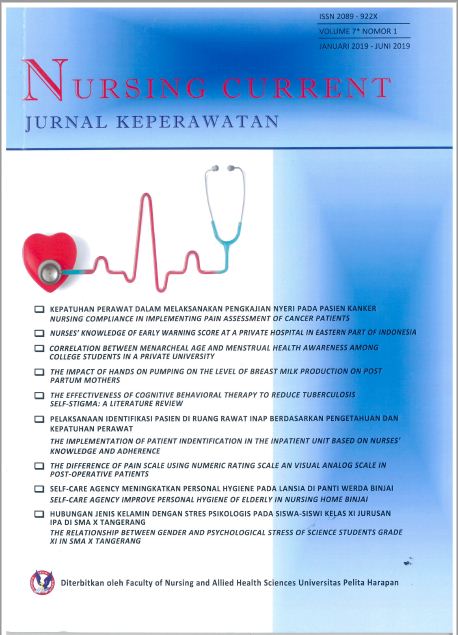PATIENT IDENTIFICATION IMPLEMENTATION IN WARD BASED ON NURSES' KNOWLEDGE AND ADHERENCE [PELAKSANAAN IDENTIFIKASI PASIEN DI RUANG RAWAT INAP BERDASARKAN PENGETAHUAN DAN KEPATUHAN PERAWAT]
DOI:
https://doi.org/10.19166/nc.v7i1.2223Schlagworte:
Patient Identification, Nurses' Knowledge, Nurses' Adherence, HospitalizationAbstract
Making errors in patient identification can cause problems and are threats to safety of patients. Nurses’ adequate knowledge and adherence to the implementation of patient identification can improve patient safety. This study used quantitative research with correlation research design. This study was conducted in the inpatient unit at a private hospital in western Indonesia with a total of 37 nurses. Data were collected using questionnaires developed and has been tested for validity and reliability. Observations were also carried out to directly observe the nurses’ behaviors in carrying out patient identification using checklist observation guide developed from the standard operational procedures of the hospital. Data were analyzed using both univariate and bivariate tests with Spearman Rank. The results of this study showed significant correlation between level of nurse’s knowledge and adherence in implementing patient identification correctly with patient identification implementation (p value = 0.049). Based on the observation of the nurses in the ward showed no significant correlation between level of knowledge and adherence and implementation of patient identification by nurses (p value = 0.159). The results of the observation of nurses was contrary to the study results collected from questionnaire that measure nurses’ adherence, thus further research is needed to identify factors that effect nurses’ adherence in implementing patient identification in in-patient unit.
BAHASA INDONESIA Kesalahan melakukan identifikasi pasien dapat menimbulkan masalah dan ancaman keselamatan pada pasien. Pengetahuan dan kepatuhan perawat yang adekuat dalam melaksanakan identifikasi pasien dapat meningkatkan keselamatan pasien. Penelitian ini menggunakan penelitian kuantitatif desain korelasi, dilakukan pada bulan Juli diruang rawat salah satu Rumah Sakit Swasta di Indonesia Barat dengan jumlah responden 37 perawat. Alat yang digunakan adalah kuesioner yang sudah diuji validitas dan reliabilitas untuk mengukur pengetahuan dan kepatuhan. Serta lembar panduan observasi berupa checklist observasi yang dikembangkan dari Standar Prosedur Operasional, untuk mengamati perilaku perawat mengidentifikasi pasien di ruang rawat inap. Data dianalisis menggunakan uji univariat dan uji bivariat dengan uji korelasi Spearman Rank. Uji korelasi Spearman Rank menunjukkan ada hubungan signifikan bersifat lemah antara tingkat pengetahuan dan kepatuhan perawat berdasarkan kuesioner (p=0,049). Berdasarkan observasi, tidak ada hubungan antara pengetahuan dan kepatuhan perawat (p=0,159). Hasil penelitian ini bertolak belakang dengan kepatuhan perawat dalam melakukan identifikasi pasien, yang diukur dengan kuesioner. Penelitian selanjutnya dapat meneliti faktor yang memengaruhi ketidakpatuhan perawat dalam melakukan pelaksanaan identifikasi pasien di ruang rawat inap.
Literaturhinweise
Bantu, A., Mulyadi, N., & Hendro, B. (2014). Hubungan Pengetahuan Perawat dengan Penerapan Identify Patient Correctly di RSUP Ratatotok Buyat Kabupaten Minahasa Tenggara. Jurnal Keperawatan, 2(2), 1-7. https://ejournal.unsrat.ac.id/index.php/jkp/article/view/5647
El-Jardali, F., Sheikh, F., Garcia, N. A., Jamal, D., & Abdo, A. (2014). Patient safety culture in a large teaching hospital in Riyadh: Baseline assessment, comparative analysis and opportunities for improvement. BMC Health Services Research, 14(1). https://doi.org/10.1186/1472-6963-14-122
Ghozali, I. (2009). Aplikasi Analisis Multivariate dengan Program SPSS. Semarang, Indonesia: UNDIP
Joint Commission International. (2017, July). Joint Commission International accreditation standards for hospitals: Including standards for academic medical center hospitals. https://www.jointcommissioninternational.org/-/media/jci/jci-documents/accreditation/hospital-and-amc/jci-standards-only_6th-ed-hospital.pdf
Komisi Akreditasi Rumah Sakit. (n.d.). Retrieved August 6, 2019, from http://www.kars.or.id/wp-content/uploads/Proposal-Bimbingan-SNARS-edisi-1-Reguler.pdf
Menteri Kesehatan Republik Indonesia. (2011). Peraturan Meteri Kesehatan Republik Indonesia Nomor 1691/Menkes/Per/VIII/2011 tentang keselamatan pasien rumah sakit. http://bprs.kemkes.go.id/v1/uploads/pdffiles/peraturan/21%20PMK%20No.%201691%20ttg%20Keselamatan%20Pasien%20Rumah%20Sakit.pdf
Quality & Risk Rumah Sakit Swasta di Indonesia Bagian Barat. (2017).
Rahmaningrum, Y. D. (2016). Hubungan Tingkat Pengetahuan dengan Kepatuhan Perawat Dalam Pelaksanakan Identifikasi Pasien Di Bangsal Rawat Inap RS PKU Muhammadiyah Bantul. http://repository.umy.ac.id/bitstream/handle/123456789/6418/NASKAH
Setiowati, D. (2010). Hubungan Kepemimpinan Head Ners Dengan Penerapan Budaya Keselamatan Pasien Oleh Perawat Pelaksana di RSUPN DR. Cipto Mangunkusumo. http://lib.ui.ac.id/file?file=digital/20282650-T%20Dwi%20Setiowati.pdf
Ulum, M., & Wulandari, R. D. (2013). Faktor yang Mempengaruhi Kepatuhan Pendokumentasian Asuhan Keperawatan berdasarkan Teori Kepatuhan Milgram. Jurnal Administrasi Kesehatan Indonesia, 1(3), 252-262. http://journal.unair.ac.id/filerPDF/jaki046514d523full.pdf
Downloads
Veröffentlicht
Zitationsvorschlag
Ausgabe
Rubrik
Lizenz
Authors who publish with this journal agree to the following terms:
1) Authors retain copyright and grant the journal right of first publication with the work simultaneously licensed under a Creative Commons Attribution License (CC-BY-SA 4.0) that allows others to share the work with an acknowledgement of the work's authorship and initial publication in this journal.
2) Authors are able to enter into separate, additional contractual arrangements for the non-exclusive distribution of the journal's published version of the work (e.g., post it to an institutional repository or publish it in a book), with an acknowledgement of its initial publication in this journal.
3) Authors are permitted and encouraged to post their work online (e.g., in institutional repositories or on their website). The final published PDF should be used and bibliographic details that credit the publication in this journal should be included.

This work is licensed under a Creative Commons Attribution-ShareAlike 4.0 International License.






